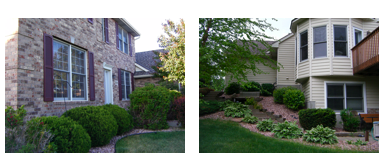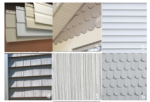Replacing siding or exterior facades of homes is much more expensive and time-consuming than changing a paint color on interior drywall, yet many home buyers focus more on interior paint colors when home-shopping than they do on the exterior walls.
If you think that’s because the type of siding on a home doesn’t really matter, think again. Some crack, others peel and fade, or dent or rot. The ones that tend to stand the test of time are brick, fiber cement and stone.
You’re not likely to find a home covered entirely in stone, but you can find ones that are all-brick, or at least with all-brick fronts, and ones that are all fiber cement. If you can purchase a home with two of these, such as both brick and fiber cement, as our featured home in Maple Grove, Minn., has, then you will be in great shape.

Brick is on the front and Nichiha Fiber Cement is on the sides and rear of our featured home at 18148 87th Pl N, Maple Grove, Minn. When buying, choose a home with brick and/or fiber cement if you want the best, most durable product on the exterior of your home.
Here is a run down of some of the siding options:
BRICK
Brick remains one of the most expensive and sturdiest of exterior home products. Few people pay to upgrade their home to a brick exterior because of the expense. So if you can find a home already clad totally or partially in brick, feel secure with your choice and go for it.
- Though expensive, brick does not require maintenance like painting or staining.
- It is fireproof and durable.
- Brick homes weather the elements well, block out noise, and are energy efficient.
FIBER CEMENT (a.k.a Cement Fiber)
- Fiber cement siding is a growing trend among upscale homes. If you’re paying more than $375,000 for a home and it isn’t all brick, check to see if it has fiber cement siding. For resale value, you don’t want to be one of the few homes in the upper price bracket that doesn’t have it (and you may think the home you’re buying is not quite in that bracket, but 10 to 15 years from now, it just might be, and do you want to be the one to pay to have it installed, or would you rather move right in now?)
- Fiber cement siding is extremely durable, very low maintenance, and made from recyclable materials so it’s “Green.”
- Fiber cement will not rot or get insect damage.
- Warranty of 30 to 50 years is common from the major manufacturers, such as James Hardie and Nichiha (the sides and back of our featured home are clad in Nichiha, which was rated in June 2009 by Consumer Reports as the best siding product. The $20,000 upgrade was added to the home in 2006 and 2007.)
- Can withstand the toughest humidity issues
- Its color does not fade
- It is shock, moisture and insect resistant.
- It is very low-maintenance.
VINYL
- Prone to cracking in cold weather, especially if subjected to impact. This is something to keep in mind, especially if you live in a cold-weather state. Hail storms in states like Minnesota have caused puncture holes the size of golf balls in vinyl siding).
- Vinyl siding will warp or buckle, especially if not properly installed.
- Vinyl is the less expensive of the siding options (i.e., sometimes you get what you pay for).
- Can’t be painted over. So if you ever tire of the color, you’ll have to replace all the siding.
- Toxins created during manufacturing and disposal.
- Colors tend to fade quickly in direct sunlight. Vinyl can be damaged in high winds and can shrink or expand in diverse temperatures.
- Vinyl can shrink or bulge when the temperature changes.
- Yes, vinyl is very popular, but that’s because it is popular among builders and DIY-home improvers, because of its low cost. Don’t confuse low cost or or popularity with a quality rating.
WOOD / CEDAR
- Painted finishes tend to require higher maintenance than do other siding options.
- Wood siding is prone to paint problems (such as cracking and peeling) if the home is not properly ventilated.
- Can be damaged by rot, insects, warping or splitting.
- Requires frequent painting and staining.
- Cedar shingles need to be painted ever so often as well as stained every 5 years to prevent mold and rotting.
STUCCO
- Moisture and mold problems can build up and cause damage to your home’s structure.
- Shows dirt, and water stains easily.
- Some insurance companies will not insure stucco homes.
ALUMINUM
- Aluminum siding is prone to scratching, denting and being noisy (yes, you can hear it rattle on a windy day)
- Aluminum lacks the ability for detailed trim work
- Standard pre-painted aluminum siding is prone to chalking.
- It is also quite difficult to make such additions as replacing windows or doors, without having to remove large sections of the siding.
- If a ladder is set against aluminum siding, the siding will dent.
Next time you’re out viewing a home, take a moment to look at the siding, and even touch it or give it a knock to see how sturdy it is. And don’t forget to have your home inspector check it out!


Nice breakdown of the different types of siding and their relationship to resale value.
By: Hardiplank Siding Houston on September 15, 2014
at 5:11 PM